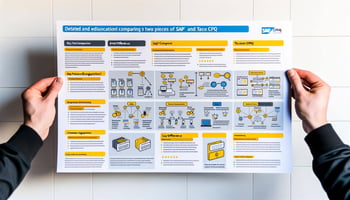I recently came across an article (link) discussing the implementation of SAP CPQ and the...
Tacton CPQ Enterprise vs. Tacton CPQ Professional
Tacton CPQ is available in two editions – Tacton CPQ Enterprise and Tacton CPQ Professional.
The Professional Edition is an out-of-the-box solution with predefined industry-specific workflows, templates and processes. This typically meets the needs of small and medium businesses looking for the advantages of a standard CPQ solution.
The Enterprise Edition can be more tailored to meet specific business requirements and extends the functionality of Tacton CPQ with even more configurability.
So, what’s the big difference?
In Tacton CPQ there are different objects very much in the same fashion as you find in CRM-systems like Salesforce and Microsoft Dynamics. Standard objects are Account, Opportunities, Solutions, Approvals, just to name a few.
In Tacton CPQ Professional all necessary objects are already predefined but new objects can not be created, but the existing objects can be tailored. In Tacton CPQ Enterprise it is possible to create new objects.
So, what does this mean?
Let me give an example…
Say that you have something called “Purchasing agreements” that gives certain customer an extra discount for selected pricelists. Both Tacton CPQ Professional and Tacton CPQ Enterprise supports pricelists, but if you want to add additional business logic to your pricing combining pricelist with account one way to do this would be to define a new object, a purchasing agreement object.
In practice this means that if the initial CPQ-analysis shows that there might be a need for one extra object there is usually no need to worry. If we wanted to solve a few “Purchasing agreements” we could extend the pricelist objects, add a few extra pricelists and the problem would have been solved.
The real difference is when there is a need for multiple new objects to sort out complex business logic. So, rule of thumb is to move to Enterprise once such complexities gets too tricky.
There are a few limitations to Tacton CPQ Professional that one needs to take into consideration. In the table below we point out the major differences in the table below.
|
|
Tacton CPQ Professional |
Tacton CPQ Enterprise |
|
Advanced Configuration |
X |
X |
|
Advanced Pricing |
X |
X |
|
Simple document generation |
X |
X |
|
Advanced document generation |
- |
X |
|
CPQ Branding |
- |
X |
|
Workflows |
X |
X |
|
Lead generation |
- |
O |
|
Industry-standard User roles |
X |
X |
|
Custom User roles |
- |
X |
|
Business approvals |
X |
X |
|
Technical approvals |
X |
X |
|
Visualization |
O |
O |
|
iPad App |
O |
X |
Tacton CPQ Professional is set up based on years of CPQ-experience to give an out-of-the-box setup ready to tackle the common CPQ challenges. In the illustration below the standard workflow and supporting objects are displayed. To put it simple; if you need to define more blue or gray boxes Tacton CPQ Professional is not for you. If you think that your business operates like most businesses, you should probably get started with Tacton CPQ Professional.
So, what about the price? Is there a difference? What do I need to pay?
We’ll let you do the math and give you a clue; if you pay the same amount of dough Tacton CPQ Professional will increase your number of users by 50 % compared with Tacton CPQ Enterprise.
It’s our firm belief that 90 % of small and medium business will be more than satisfied with Tacton CPQ Professional. After a CPQ Analysis workshop we can tell you for sure.




